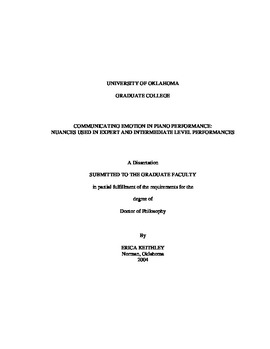| dc.contributor.advisor | Barry, Nancy, | en_US |
| dc.contributor.advisor | Magrath, Jane, | en_US |
| dc.contributor.author | Keithley, Erica. | en_US |
| dc.date.accessioned | 2013-08-16T12:19:31Z | |
| dc.date.available | 2013-08-16T12:19:31Z | |
| dc.date.issued | 2004 | en_US |
| dc.identifier.uri | https://hdl.handle.net/11244/782 | |
| dc.description.abstract | The purpose of this study was to determine how specific basic emotions were communicated in expert and intermediate level piano performances through the use of musical nuances. Two intermediate and two expert pianists recorded performances of three musical excerpts. Pianists performed each excerpt in four different ways, once to communicate each of the following basic emotions: happiness, sadness, anger, and tenderness. Excerpts were performed on a Yamaha Disklavier and recorded as both audio CD tracks and MIDI files. Pianists were also interviewed to gather information concerning which nuances they planned to use to express each emotion. To determine the effectiveness of each pianist's emotional communication, 186 participants listened to recordings of these performances and rated each performance on its communication of the four emotions and its musical appeal. Each listener also provided information concerning his or her age and musical experience. MIDI data for performances were analyzed to determine how nuances of articulation, tempo, dynamics, pedal use, and voicing were used systematically by pianists. | en_US |
| dc.description.abstract | Results showed that both expert and intermediate level pianists were able to communicate basic emotions to listeners through their performances. Pianists varied widely in the ability to communicate emotion to listeners, with pianists' accuracy rates ranging from 25% to 75%. Pianists used specific nuances of articulation, tempo, timing, and dynamics to communicate the four emotions in ways that correspond to results of prior studies. This study also found that high happiness ratings were correlated with little damper pedal use, high sadness ratings were associated with significant damper pedal use and playing the melody louder than the accompaniment, high anger ratings were correlated with playing the accompaniment louder than the melody and little chord asynchrony, and high tenderness ratings were associated with significant damper pedal use, playing the melody louder than the accompaniment, and chord asynchrony. A MANOVA indicated that listeners found experts' performances to be significantly more musically appealing than intermediate level pianists' performances. Examination of interview data and MIDI nuance data indicated that most pianists were self-aware concerning the nuances that they used to communicate emotions. | en_US |
| dc.format.extent | xi, 250 leaves : | en_US |
| dc.subject | Piano music Interpretation (Phrasing, dynamics, etc.) | en_US |
| dc.subject | Communication in music. | en_US |
| dc.subject | Piano Performance. | en_US |
| dc.subject | Music. | en_US |
| dc.subject | Education, Music. | en_US |
| dc.title | Communicating emotion in piano performance: Nuances used in expert and intermediate-level performances. | en_US |
| dc.type | Thesis | en_US |
| dc.thesis.degree | Ph.D. | en_US |
| dc.thesis.degreeDiscipline | School of Music | en_US |
| dc.note | Advisers: Nancy Barry; Jane Magrath. | en_US |
| dc.note | Source: Dissertation Abstracts International, Volume: 65-08, Section: A, page: 2827. | en_US |
| ou.identifier | (UMI)AAI3143542 | en_US |
| ou.group | Weitzenhoffer Family College of Fine Arts::School of Music | |
